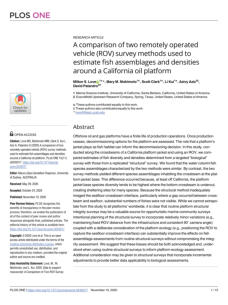Environmental studies 2019 - 2020









Authors:
Kaitlin N. Allen & José Pablo Vázquez-Medina
Reperfusion injury follows ischemia/reperfusion events
occurring during myocardial infarction, stroke, embolism,
and other peripheral vascular diseases. Decreased blood
flow and reduced oxygen tension during ischemic
episodes activate cellular pathways that upregulate pro-
inflammatory signaling and promote oxidant generation.
Reperfusion after ischemia recruits inflammatory cells to
the vascular wall, further exacerbating oxidant production
and ultimately resulting in cell death, tissue injury, and
organ dysfunction.
Diving mammals tolerate repetitive episodes of peripheral
ischemia/reperfusion as part of the cardiovascular
adjustments supporting long-duration dives. These
adjustments allow marine mammals to optimize the use of
their body oxygen stores while diving but can result in
selectively reduced perfusion to peripheral tissues.
Remarkably, diving mammals show no apparent
detrimental effects associated with these
ischemia/reperfusion events. This study reviews the
knowledge regarding the strategies marine mammals use
to suppress inflammation and cope with oxidant
generation potentially derived from diving-induced
ischemia/reperfusion.

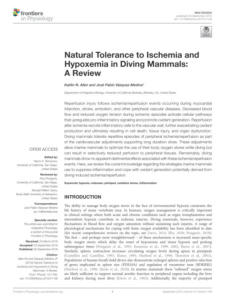

Authors:
Christine Erbe, Sarah A. Marley, Renée P. Schoeman,
Joshua N. Smith, Leah E. Trigg, and Clare Beth
Embling.
Abstract:
A concomitant increase in underwater noise has been
reported in several regions around the globe. Given the
important role sound plays in the life functions of marine
mammals, research on the potential effects of vessel noise
has grown—in particular since the year 2000. This study
provides an overview of this literature, showing that
studies have been patchy in terms of their coverage of
species, habitats, vessel types, and types of impact
investigated.


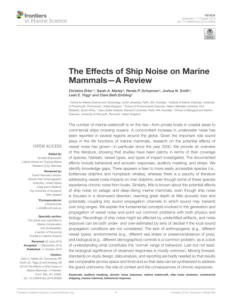

Authors:
Andreas Fahlman, Bruno Cozzi, Mercy Manley, Sandra
Jabas, Marek Malik, Ashley Blawas, and Vincent M.
Janik.
Abstract:
Previous reports suggested the existence of direct somatic
motor control over heart rate (fH) responses during diving
in some marine mammals as the result of a cognitive
and/or learning process rather than being a reflexive
response. This would be beneficial for O2 storage
management but would also allow ventilation-perfusion
matching for selective gas exchange, where O2 and CO2
can be exchanged with a minimal exchange of N2. Such
a mechanism explains how air-breathing marine
vertebrates avoid diving-related gas bubble formation
during repeated dives and how stress could interrupt this
mechanism and cause excessive N2 exchange. To
investigate the conditioned response, the authors
measured the fH-response before and during static
breath-holds in three bottlenose dolphins (Tursiops
truncatus) when shown a visual symbol to perform either
a long (LONG) or short (SHORT) breath-hold or during a
spontaneous breath-hold without a symbol (NS).

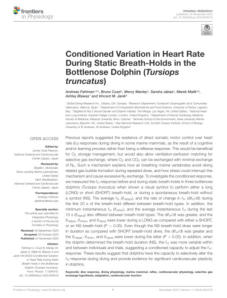

Authors:
Alexander O. MacGillivray, Zizheng Li, David E. Hannay,
Krista B. Trounce, & Orla M. Robinson.
In 2017, the Vancouver Fraser Port Authority’s Enhancing
Cetacean Habitat and Observation program carried out a
two-month voluntary vessel slowdown trial to determine
whether slowing to 11 knots was an effective method for
reducing underwater radiated vessel noise. The test was
carried out in Haro Strait, British Columbia, in the critical
habitat of endangered southern resident killer whales.


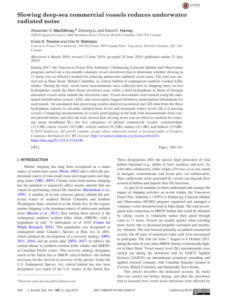

Author:
Jacquomo Monk, Neville Barrett, Todd Bond, Ashley
Fowler, Dianne McLean, Julian Partridge, Nicholas
Perkins, Rachel Przeslawski, Paul G Thomson, Joel
Williams
ROVs were initially designed in the mid-1980s to
complement manned scientific submersibles. With the
increase in technology, ROVs have gained acceptance
because of their distinct advantages over manned
submersibles in many areas, notably reduced risk to pilots
and researchers.



Authors: Mariana Girão, Inês Ribeiro, Tiago Ribeiro,
Isabel C. Azevedo, Filipe Pereira, Ralph
Urbatzka, Pedro N. Leão, and Maria F.
Carvalho.
Nature is the major reservoir of biologically active
molecules. The urgent need of finding novel molecules for
pharmaceutical application is prompting the research of
underexplored environments, such as marine ecosystems.
The authors of this paper investigated cultivable
actinobacteria associated with the macroalgae Laminaria
ochroleuca and assessed their potential to produce
compounds with antimicrobial or anticancer activities.



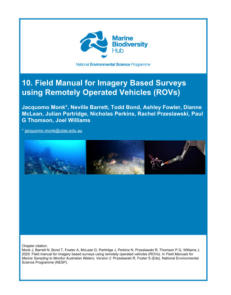

Author: Polina Lemenkova
Urbanization in Turkey has impressive expansion rates
from 18.5% in 1950 to 62% in 2000. Such uncontrolled
expansion leads to a gradual decrease in fertile landscapes
and agricultural areas along the Aegean coasts and
increases the pollution of waters. The chemical
contamination in Izmir bay (mercury originating from
Gediz River and inactive mining sites in Karaburun
Peninsula) comes to the shelf waters. Consequently, the
detected mercury in selected plankton organisms exceeds
the acceptable standards as a maximal limit in living
creatures.

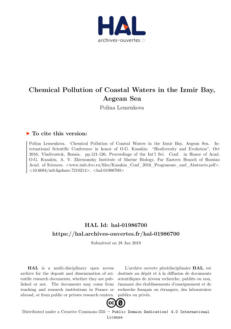

Authors:
N. Remez, A. Dychko, L. Yevtieieva, S. Kraychuk, N.
Ostapchuk, J. Oliinyk
This paper provides a simple mathematical model that
describes the synergistic interaction of environmental
factors that occur in urban ecosystem. The model predicts
the value of maximum synergistic action and the condition
for its achievement, as well as implies the dependence of
synergistic action on the intensity of the agents used and
the proportion of irreversible damages after the combined
effects. The developed mathematical model can be used
to predict the accumulation of pollution in the ground
layer of soil.




Author:s
Leo posthuma, Michiel C. Zijp, Dick De Zwart, Dik Van de
Meent, Lidija Globevnik, Maja Koprivsek, Andreas
Focks, Jos Van Gils, & Sebastian Birk
This study aims to demonstrate that the current approach
of chemical impact assessment, consisting of comparing
measured concentrations to protect environmental quality
standards for individual chemicals, is not optimal.




Author:s
Estelle Baurès, Alexandre Baudet, Olivier Blanchard,
Hélène Guegan, Monique Guillaso, Pierre le Cann,
Jean-Pierre Gangneux, Arnaud Florentin
Air quality in public and working establishments is
essential, especially where people are potentially
vulnerable. It is precisely the case with healthcare
institutions. This study aims to describe these facilities'
microbiological, chemical, and particulate pollution of the
indoor environment.

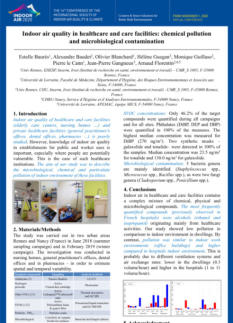

Author:s
Ravi Naidu, Bhabananda Biswas, Ian R. Willett, Julian
Cribb, Brajesh Kumar Singh, C. Paul Nathanail, Frederic
Coulon, Kirk T. Semple, Kevin C. Jones, Adam Barclay,
Robert John Aitken
Anthropogenic chemical pollution has the potential to
pose one of the largest environmental threats to
humanity, but global understanding of the issue remains
fragmented. This article presents a perspective of the
threat of chemical pollution to humanity, emphasising
male fertility, cognitive health and food security.



Authors:
Jiaqi Wang, Leonie S. Lautz, Tom M. Nolte, Leo Posthuma,
Remon Koopman, Rob S.E.W. Leuven, A. Jan Hendriks
The impact of chemical pollution on ecosystem services is
rarely quantified, and the ecosystem service valuation
often focuses on individual services without considering
the total services provided by the ecosystem. The study
aimed to develop a stepwise approach to quantify the
impact of sediment pollution on the entire ecosystem
service value offered by water systems


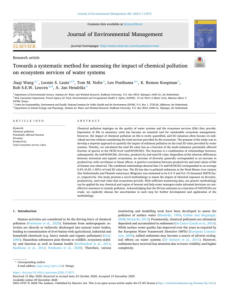


Authors: Reshma P. Vengaloor, Aparnna Ajay, Jessica
Sandhiya, Ashrith Sriram Raju, Dhanush.S
Almost all organisms on this planet are affected by water,
including humans. As a result of water pollution, many
marine ecosystems and freshwater ecosystems have been
disturbed. Plastics make up most of the waste. Besides
stagnation, they are also eaten by aquatic and terrestrial
animals, which is a great threat to their existence.
Keeping domestic water bodies clean can solve many of
the problems that threaten the existence of aquatic
organisms. This problem has been addressed by
developing the AQUA ROVER

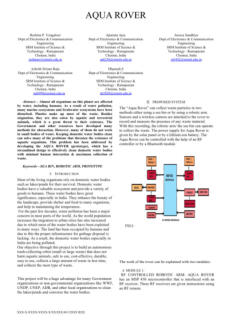

Publisher: United Nations
The "Manual of Tests and Criteria" contains criteria, test
methods, and procedures to be used for the classification
of dangerous goods according to the provisions of the
"United Nations Recommendations on the Transport of
Dangerous Goods, Model Regulations", as well as of
chemicals presenting physical hazards according to the
"Globally Harmonized System of Classification and
Labeling of Chemicals (GHS)".

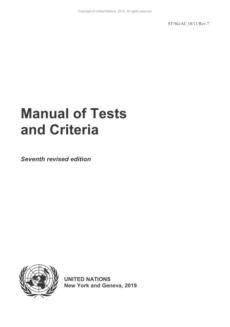

Authors:
Dr. Nagham Mahmood Aljamali, Dr. Aseel Mahmood
Jawad, Anaam Jawad Alabbasy, Dr. Layla Ali Mohammed
Salih
This review deals with the causes of pollution and their
effect on health and the environment. Also, it involves
essential forms of contamination like environmental,
chemical, radiation, soil, water, thermal, biological, and
medical pollution that killed millions of people in many
countries.


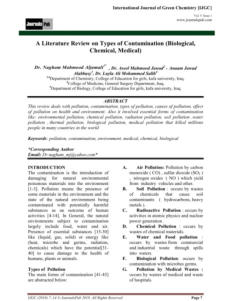

Authors: Walter Dellisanti, Ryan H. L. Tsang, Put Ang Jr,
Jiajun Wu, Mark L. Wells, and Leo L. Chan
Underwater visual monitoring methods are used broadly
to evaluate coral reef conditions in the natural
environment, but quantitative measurements of the coral
holobiont have mainly been restricted to the photo-
physiological assessment of the endosymbionts. An
underwater respirometer has been designed to make
routine, diver-operated, non-invasive measurements at
coral surfaces, but the reality in situ accuracy and precision
capabilities of this device has not been critically assessed,
an essential step if these measurements are to help
quantify spatial and seasonal patterns of coral metabolism.


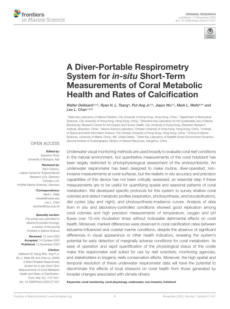

Authors:
Miriam Römer, Chieh-Wei Hsu, Markus Loher, Ian R.
MacDonald, Christian dos Santos Ferreira, Thomas
Pape, Susan Mau, Gerhard Bohrmann, and Heiko
Sahling
This multi-disciplinary study of the hydrocarbon seepage
system at Tsanyao Yang Knoll (TYK) in the southern Gulf of
Mexico illustrates the amount and fate of hydrocarbons
(mainly oil and methane) emanating from the sea floor
structure and rising through a 3400 m water column.




Authors:
Steven R. Auscavitch, Mary C. Deere, Abigail G. Keller,
Randi D. Rotjan, Timothy M. Shank, and Erik E.
Cordes
The authors of this paper present baseline deep-sea coral
species distribution and community assembly patterns
within the Scleractinia, Octocorallia, Antipatharia, and
Zoantharia with respect to different sea floor features and
abiotic environmental variables across bathyal depths
(200–2500 m).


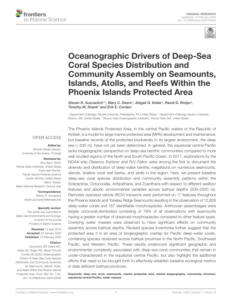

Author:
Pedro H. López-Garrido, James P. Barry, Juan Ignacio
González-Gordillo, and Elva Escobar-Briones
Current knowledge of invertebrate communities in hard
bottom habitats at depths > 200 m is poor due to the
methodological limitations inherent in sampling deep
habitats. Using video imagery of benthic habitats coupled
with environmental data from the Remotely Operated
Vehicle, the authors documented variation in the diversity
and community composition from 849 to 990 m depth in
the NW limit of the Guaymas Basin, in relation to dissolved
oxygen and substrate characteristics.


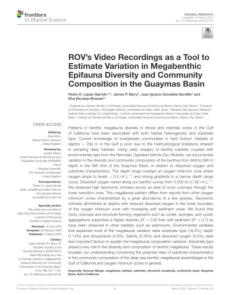

Author:
Victoria L. G. Todd, Laura Lazar, Laura D. Williamson,
Ingrid T. Peters, Aimee L. Hoover 1 , Sophie E. Cox 1
, Ian. B. Todd 1 , Peter I. Macreadie, and Dianne L.
McLean
This study used routine, incidentally collected ROV (n = 73)
and commercial diver (n = 9) video recordings spanning
1998–2019 globally. Data were gathered directly from
industrial partners (n = 36) and the public domain
(YouTube; n = 46) to provide an account of marine
megafauna presence and potential feeding behavior in
the near-visible vicinity of subsea anthropogenic structures.

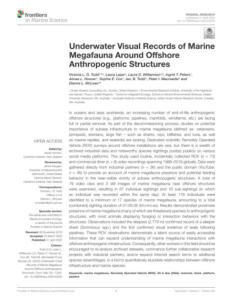


Authors: Tomasz Wolski, Bernard Wisniewski
Fluctuating sea levels are an important element of
hydrodynamic processes that occur in coastal regions.
Extreme sea levels can stimulate currents, sea abrasion,
and the accumulation of sedimentary material in various
coastal sections.
The objective of this study was to examine the
geographical diversity of extreme sea levels along the
entire Baltic Sea coast based on hourly sea levels from 37
tide gauges between 1960 and 2010. In this study,
8 Baltic Sea sub-basins (water regions) with similar sea
level fluctuation patterns were identified using cluster
analysis.
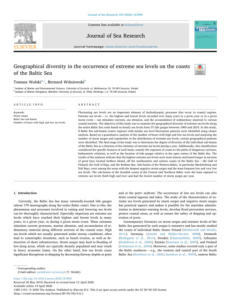

Click on the
octopus to return to
the top of the page
Authors: Apostolos Tsouvalas
Installing piles is crucial for building new wind farms, but it
also generates significant underwater noise pollution. This
paper provides a comprehensive review of the latest
computational methods used to predict underwater noise
generated by offshore foundation pile installation, as well
as existing noise mitigation strategies. Additionally, it
identifies future challenges in the field, taking into account
the increasing size of wind turbines and new pile-driving
technologies.

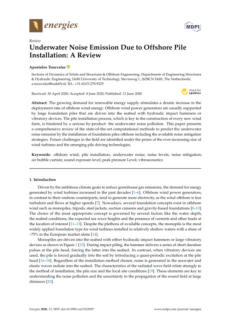

Authors:
S. Veerasingam , M. Ranjani , R. Venkatachalapathy ,
Andrei Bagaev , Vladimir Mukhanov , Daria Litvinyuk , M.
Mugilarasan , K. Gurumoorthi , L. Guganathan , V. M.
Aboobacker & P. Vethamony
The goal of this article is to critically review the
identification of microplastics in different environmental
matrices using the "Fourier transform infrared (FTIR)
spectroscopy" technique, which consists of measuring
how much light a sample absorbs at each wavelength. It
also discusses the limitations of this method and explores
ways to improve and standardize practices.


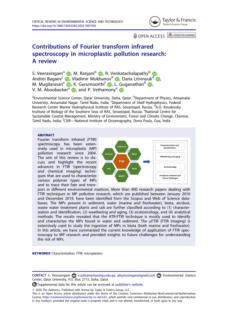
Authors: Shane Guan, & Robert Miner
Although down-the-hole (DTH) pile driving is increasingly
used for in-water pile installation, the characteristics of
underwater noise from DTH pile driving are largely
undocumented and unstudied. This study presents a
comprehensive analysis of the noise characteristics during
DTH pile driving of two steel pipe piles in shallow waters
off Southeast Alaska.


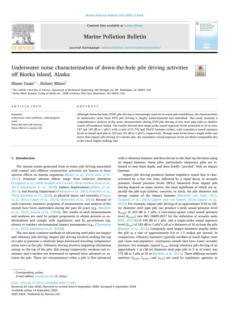
Authors: Samuel L. Denes, Michelle J. Weirathmueller,
Elizabeth T. Küsel
Underwater noise from platform foundation construction
is mainly caused by impact pile driving. Other noise
sources include vessel thrusters. This report presents the
results of acoustic modeling for pile driving activities. They
are presented as single-impact radial distances to various
nominal sound pressure levels, sound exposure levels, and
zero-to-peak pressure levels.


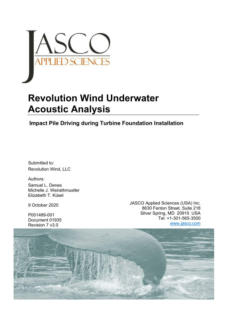

Authors: Y. Bernaldo de Quiros, A. Fernandez, R.W. Baird,
R.L. Brownell Jr, N. Aguilar de Soto, D. Allen, M.
Arbelo, M. Arregui, A. Costidis, A. Fahlman, A.
Frantzis F. M. D. Gulland, M. Inıguez, M. Johnson,
A. Komnenou, H. Koopman, D. A. Pabst, W. D.
Roe, E. Sierra, M. Tejedor, & G. Schorr
This article raises awareness about the correlation
between naval mid-frequency active sonar (MFAS) and
mass stranding events (MSEs) of beaked whales (BWs). It
highlights the historical context, research findings, and
effectiveness of mitigation measures such as the MFAS
ban in the Canary Islands. The authors suggest similar
spatial management strategies should be implemented in
other regions to protect beaked whale populations.



Publisher:
US office of Energy Efficiency & Renewable Energy
This document explains the efforts and initiatives of the
U.S. Department of Energy's Water Power Technologies
Office (WPTO) in exploring and advancing marine energy
technologies. It discusses the potential of marine energy
resources, the geographical diversity of these resources,
and the WPTO's focus on improving performance and
reducing the costs of marine energy generation.
Additionally, it highlights the WPTO's fact-finding mission
to identify new markets for marine energy beyond the
grid, such as providing power at sea and meeting the
energy needs of coastal and rural island communities.


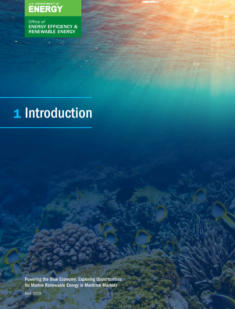



Publisher: World Health Organization
This document from the World Health Organization aims
to inform and raise awareness about the health risks
associated with benzene exposure and advocate for
public health actions to reduce such exposure.
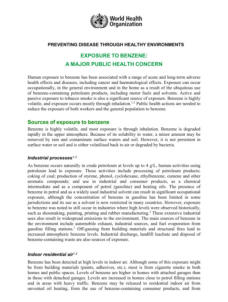

Authors: Sean van Elden, Jessica J. Meeuwig, Richard J.
Hobbs and Jan M. Hemmi
This article discusses the ecological implications of
decommissioning offshore oil and gas platforms and
proposes the use of the new ecosystem approach as a
framework for managing them. It highlights the ecological
importance of these platforms as artificial reefs, the
challenges associated with their removal, and the
potential benefits of recognizing and managing them as
novel ecosystems rather than attempting to restore the
original ecosystem.


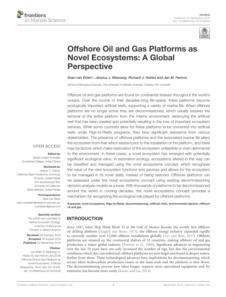

Authors:
Enrique Montes, Anni Djurhuus, Frank E. Muller-Karger,
Daniel Otis, Christopher R. Kelbl, & Maria T. Kavanaugh
This study, part of the Marine Biodiversity Observation
Network (MBON) demonstration project and managed by
NOAA, characterizes seascapes in the Florida Keys
National Marine Sanctuary (FKNMS) and the southwest
Florida shelf nearshore environment using multivariate
satellite and in situ measurements of Essential Ocean
Variables and Essential Biodiversity Variables to analyze
physical, chemical, geological, and biological factors that
shape marine environments. The research focuses on
three specific periods in 2016 and involves collecting data
on bio-optical parameters.


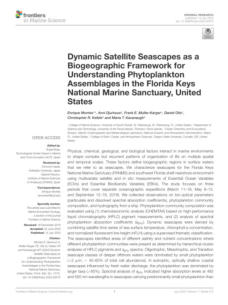
Authors:
U.S. Department of the Interior Bureau of Ocean Energy
Management Office of Renewable Energy Programs
This paper intends to inform stakeholders about the
potential effects of offshore wind foundations on the
marine environment along the Atlantic coast of the United
States and address public concerns by summarizing
available scientific knowledge and comparing different
foundation types. It seeks to provide stakeholders with
information on the direct and indirect impacts of these
foundations on marine species and habitats, as well as to
explain the conditions under which different foundation
types are suitable. Additionally, the text acknowledges that
some stakeholders view offshore wind farm foundations
as beneficial artificial reefs that support marine life.


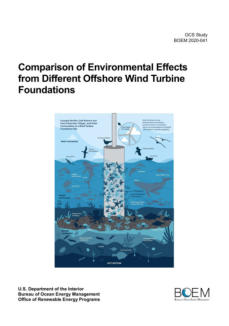

Author:s
Matthias Obst, Katrina Exter, A. Louise Allcock, Christos
Arvanitidis, Alizz Axberg, Maria Bustamante, Ibon Cancio,
Diego Carreira-Flores, Eva Chatzinikolaou, Giorgos
Chatzigeorgiou, Nathan Chrismas, Melody S. Clark, Thierry
Comtet, Thanos Dailianis, Neil Davies, Klaas Deneudt,
Oihane Diaz de Cerio, Ana Fortic, Vasilis Gerovasileiou,
Pascal I. Hablützel, Kleoniki Keklikoglou, Georgios Kotoulas,
Rafal Lasota, Barbara R. Leite, Stéphane Loisel, Laurent
Lévêque, Liraz Levy, Magdalena Malachowicz, Borut
Mavric, Christopher Meyer, Jonas Mortelmans, Joanna
Norkko, Nicolas Pade, Anne Marie Power, Andreja
Ramšak,Henning Reis, Jostein Solbakken, Peter A. Staehr,
Per Sundberg, Jakob Thyrring, Jesus S. Troncoso,
Frédérique Viard, Roman Wenne , Eleni Ioanna
Yperifanou, Malgorzata Zbawicka, & Christina Pavloudi
This document announces and describes the
establishment and results of a Marine Biodiversity
Observation Network (MBON) using Autonomous Reef
Monitoring Structures (ARMS). This network aims to
monitor and assess changes in marine hard-bottom
communities, particularly benthic fauna, using genomic-
based methods like DNA metabarcoding combined with
image-based identifications.



Authors: Luca Riboldi, Erick F. Alves, Marcin Pilarczyk,
Elisabetta Tedeschi, & Lars O. Nord
This paper presents and evaluates an innovative hybrid
energy system designed to provide stable power and heat
to offshore oil and gas installations. The system integrates
offshore wind, onshore gas turbines, and an energy
storage system based on fuel cells and electrolyser stacks.
The paper aims to demonstrate the potential of this system
and discusses the development of an integrated model to
simulate the performance of the system, in addition to a
rigorous analysis and optimization process to identify the
best design.


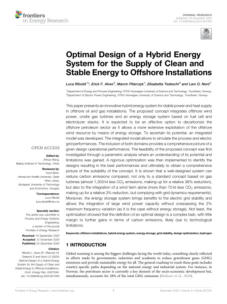

Authors: D.S. Ivanov, G.S. Ammosov, Z.G. Kornilova
This analysis discusses the challenges and factors affecting
the efficiency and stability of trunk gas pipelines, specifically
focusing on the underwater crossing of the Lena River in
Yakutia. It highlights the technical and environmental
challenges, such as soil erosion, climatic conditions, and
the need for additional materials, which impact
construction costs and pipeline integrity, highlighting
complexities involved in maintaining the planned-high-
altitude position of the pipeline and the influence of
natural processes on its operation.

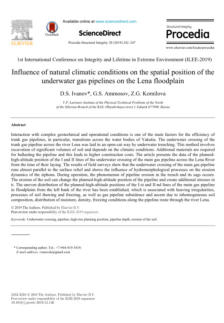

Author: Hanna Heidemann, and Joachim Ribbe
This paper presents a scientific investigation into the
occurrence and spatial variability of marine heat waves
(MHWs) off the southeast coast of Queensland, Australia,
to identify patterns in sea surface temperature (SST)
variability in key ecological hotspots, analyze the impact of
El Niño events on MHWs, and highlight the influence of
local weather patterns and oceanic heat advection on
these phenomena. Additionally, it suggests the
importance of conducting similar studies in other regional
shelves and coastal systems due to the pressures of
human activities and climate change.

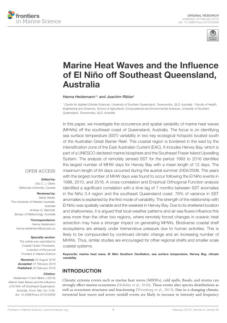

Author: Rachel L. Mugge, Melissa L. Brock, Jennifer L.
Salerno, Melanie Damour, Robert A. Church, Jason
S. Lee, and Leila J. Hamdan
This study examined the impact of the Deepwater Horizon
oil spill on the preservation of historic shipwrecks in the
Gulf of Mexico, focusing on how the spill affects biofilm
communities on submerged steel structures, which play a
crucial role in reef preservation and biodiversity. It details
the methodology used to assess the impact, including the
placement of carbon steel disks at various shipwreck sites,
the analysis of biofilm and microbiome samples, and the
findings related to gene abundance and metal loss,
providing evidence of the long-term environmental effects
of the oil spill on marine ecosystems and historic
preservation.

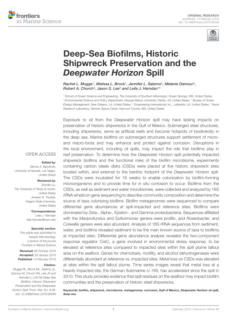

Authors: Michael Vecchione
This document shares scientific observations and findings
from recent remotely operated vehicle (ROV) dives in the
central Pacific Ocean. The author aims to provide insights
into the natural history of cephalopods, specifically
focusing on the reproductive behavior of deep-sea squids
and cirrate octopods. It highlights specific examples and
observations, such as potential spawning aggregations
and unique egg hatching mechanisms, to contribute to
the understanding of deep-sea animal behavior and
biology.




Authors: Kyra A. Price, Cody E. Garrison, Nathan Richards,
and Erin K. Field
This study focuses on understanding the microbial
communities associated with the Pappy Lane shipwreck in
Pamlico Sound, North Carolina, to identify differences in
microbial communities across the shipwreck and its
surrounding environment and how these communities
contribute to its preservation or deterioration. It also
highlights the discovery of a novel strain of
Zetaproteobacteria and its potential role in
biogeochemical cycling, with implications for better
management and preservation strategies for shipwrecks as
artificial reefs and cultural resources.



Authors:
Philipp Fischer, Holger Brix, Burkard Baschek, Alexandra
Kraberg, Markus Brand, Boris Cisewski, Rolf Riethmüller,
Gisbert Breitbach, Klas Ove Möller, Jean-Pierre Gattuso,
Samir Alliouane, Willem H. van de Poll, and Rob Witbaard
This study discusses the development, operation, and
challenges of cabled coastal observatories, focusing on
the "COSYNA Shallow Water Underwater Node" system. It
aims to highlight the technological advancements and
benefits of these observatories for marine science, as well
as the complexities involved in their operation, providing
an overview of the capabilities and experiences gained
from using such technology in marine research,
particularly in challenging environments like the polar seas
and the North Sea.





03 - Microplastics in Mediterranean Sea: A protocol to robustly assess
contamination characteristics
Authors: Mikael Kedzierski, Jonathan Villain, Mathilde
Falcou-Prefol, Marie Emmanuelle Kerros,
Maryvonne Henry, Maria Luiza Pedrotti,
Stephane Bruzaud
This study proposes a protocol to analyze microplastics for
particle size distribution and chemical nature, based on
data from the Tara Mediterranean campaign. It shows
that only 3% of collected microplastics need analysis for
precise scale views and 17.7% for overview manta per
manta, making this approach a practical contribution to
microplastic studies.
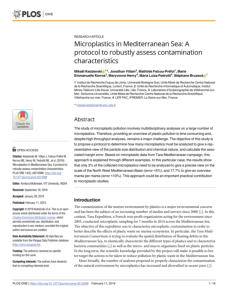



09 - Quantifying the protective capacity of mangroves from storm
surges in coastal Bangladesh
Author: Susmita Dasgupta, Saiful Islam, Mainul Huq,
Zahirul Huque Khan, Raqubul Hasib
Mangroves provide crucial protection against cyclonic
storm surges by obstructing water flow through tree
roots, trunks, and leaves. The extent of mangrove
protection depends on tree planting density, trunk and
root diameter, and forest characteristics. This study in
Bangladesh estimated the reduction in storm surge
height and water flow velocity from mangroves at
selected sites. Its results showed a significant decrease in
water flow velocity and a modest reduction in surge
height, suggesting that healthy mangroves can save on
rehabilitation and maintenance costs by protecting
embankments from damage.
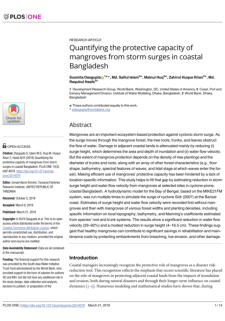


17 - Scenarios of Deoxygenation of the Eastern Tropical North
Pacific During the Past Millennium as a Window Into the Future
of Oxygen Minimum Zones.
Authors: Konstantin Choumiline, Ligia Pérez-Cruz,
Andrew B. Gray, Steven M. Bates, and Timothy
W. Lyons
Studies predict global expansion of Oxygen Minimum
Zones (OMZs) due to anthropogenic global warming.
Sediment core paleorecords show contradictory trends,
particularly in the Eastern Tropical North Pacific (ETNP).
The OMZ expanded due to increased upwelling and
productivity during cold intervals, with most hypoxic times
occurring during the Little Ice Age. Solar forcing likely
influences oxygen variability.



19 - Chemical and biological dispersants differently affect the
bacterial communities of uncontaminated and oil-contaminated
marine water
Authors: Camila Rattes de Almeida Couto, Deborah
Catharine de Assis Leite, Diogo Jurelevicius, &
Jan Dirk van Elsas, & Lucy Seldin
The study investigates the use of biosurfactants,
particularly surfactin, in marine environments for oil spill
remediation, showing that bacteria, particularly
bacteriophages, were abundant in the microcosms, with
surfactin-treated microcosms showing higher predicted
gene abundance for petroleum hydrocarbon
degradation. It also highlights the potential of
biosurfactants in marine environments.
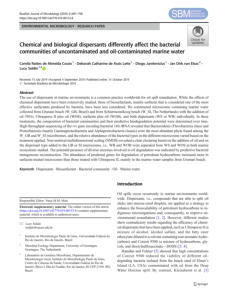


23 - Biosurfactant Production in Sub-Oxic Conditions Detected in
Hydrocarbon-Degrading Isolates from Marine and Estuarine
Sediments
Authors: Patrícia M. Domingues, Vanessa Oliveira, Luísa
Seuanes Seram,
This study screened bacteria from deep sub-seafloor
sediments and estuarine sub-surface sediments for
potential biosurfactant (BSF) production. Twelve isolates
were identified, all capable of producing BSFs under
aerobic and anaerobic conditions. These isolates could be
used in bioremediation or microbial oil recovery strategies
under oxygen limitations.
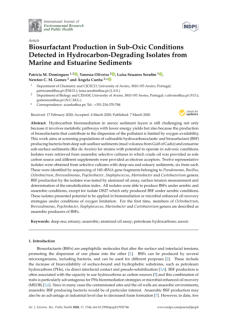


30 - Hydrocarbon seepage in the deep seabed links subsurface and
seafloor biospheres
Authors: Anirban Chakraborty, S. Emil Ruff, Xiyang Dong,
Emily D. Ellefson, Carmen Li, James M. Brooks,
Jayme McBee, Bernie B. Bernard, and Casey R. J.
Hubert
Marine cold seeps transport fluids between subseafloor
and surface biospheres through hydrocarbon migration.
Gas seeps contain distinct microbial communities,
including bacteria and archaea. Petroleum geofluids
facilitate upward microbial dispersal, shaping the
microbiome of cold seep sediments and maintaining
microbial diversity in the deep sea.
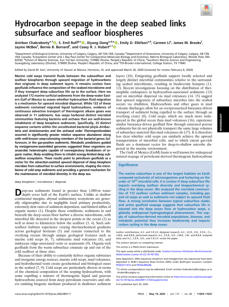


37 - Environmental effects of offshore produced water discharges: A
review focused on the Norwegian continental shelf
Authors: Jonny Beyer, Anders Goksoyr, Dagoystein
Hjermann, Jarle Klungsoyr
Offshore produced water (PW) is a significant byproduct
of oil and gas extraction, containing harmful pollutants like
crude oil, PAHs, APs, and metals. Despite regulations,
greener chemicals, and improved cleaning systems, PW
remains the largest source of oil pollution to the sea.
Monitoring surveys show detectable exposures in mussel
and fish, but biomarkers show only mild acute effects. The
sub-Arctic Southern Barents Sea is also uncertain, with
sub-arctic species similar to temperate species.
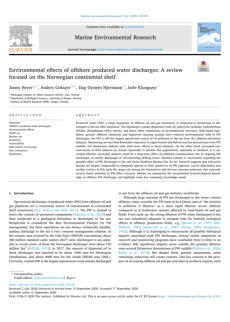


48 - Marine Pollution Mitigation by Waste Oils Recycling Onboard
Ships: Technical Feasibility and Need for New Policy and
Regulations
Authors: Michela Mazzoccoli, Marco Altosole, Veronica
Vigna, Barbara Bosio, and Elisabetta Arato
This paper presents a preliminary feasibility of a waste
recycling technology for ships, aiming to obtain marine
fuel oil from sludge through a pyrolysis process in a small
reactor onboard. This technology is designed for ship
operation under different constraints compared to
traditional land plants. Although preliminary lab tests and
simulation results are promising, technical criticalities and
lack of mandatory regulations hinder shipowners'
motivation to invest in such technologies.
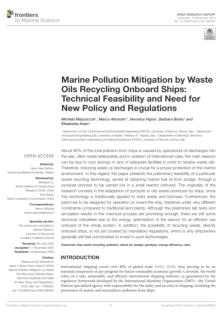



49 - Exposure assessment of Rayong oil spill cleanup workers
Authors: Thammasin Ingviya, Chanthip Intawong,
Salahaddhin Abubaker, Paul T. Strickland
This study quantifed the internal dose of polycyclic
aromatic hydrocarbons (PAHs) and benzene in 1,262 oil
spill cleanup workers. Frozen urine samples were
collected from workers during the one-month cleanup
period. Results showed that the internal dose of 1-OHPG
was highest in the first three days of cleanup work and
66.7% lower in the final week. The decline in urinary 1-
OHPG concentration with days of cleanup remained
significant.
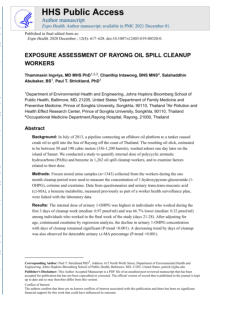

Authors: Milton S. Love, Mary M. Nishimoto, Scott Clark, Li
Kui, Azivy Aziz, David Palandro
This article examines the relationship between offshore oil
platform decommissioning and fish habitats, emphasizing
the importance of fish diversity in decision-making.
Through a study comparing two survey methodologies at
a California platform, the findings reveal that while water
column fish species were similar across methods, the
assemblages at the jacket base differed significantly due to
structural inadequacies in capturing the seafloor-
crossbeam interface. Recommendations for enhancing
structural surveys for better ecological assessment are
provided, highlighting the need for intentional survey
planning.


